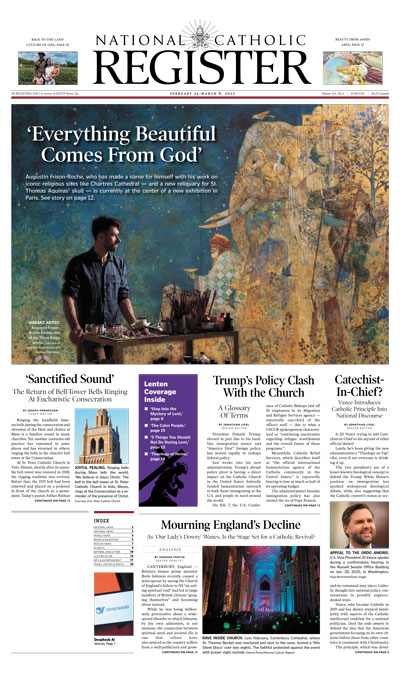St. Rafał Kalinowski, Pray for Us!
SAINTS & ART: The spiritual influence of Kalinowski (1835-1907) was marked on Karol Wojtyła, the future St. John Paul II, who canonized him in 1991.

A 19th-century Pole whose influence on St. John Paul II was great (even though he died 13 years before the future pope was born), Rafał Kalinowski was born Józef in 1835 in Vilnius, now the capital of Lithuania.
He spent his early life and education in that triangle we now call Lithuania-Belarus-Russia. Because his father was a teacher there, he received a fine education at the School for Nobility in Vilnius, followed by two years of studies in agronomy and four at the St. Petersburg Academy of Military Engineering, where he earned a degree in engineering and appointment in the Russian Army as a lieutenant. (Poland had been erased from European maps from 1795-1918 by the Russians, Austrians and Prussians; education and professional advancement often had to take place under one of the occupiers.) He was then appointed lecturer in mathematics at the Academy and took part in designing the Kursk-Kyiv-Odessa Railroad (now all points in Russia’s war against Ukraine).
In 1863, Poles in the Russian Partition rose against their occupiers, and Kalinowski resigned from the Russian Army so as not to fight against his countrymen. He then joined the January Uprising and took the role of the insurgents’ acting War Minister for the Vilnius Region, though he quickly concluded the Uprising was doomed. When the Russians suppressed the Uprising bloodily, Kalinowski was arrested and sentenced to death, later commuted to 10 years of hard labor in a salt mine in Siberia near the present Mongolian border, from which he returned from exile in 1874. The return was not immediate from the camp, however.
Before the Uprising, Kalinowski was practically religiously indifferent, even arguably skeptical. He read St. Augustine’s Confessions in the late 1850s but admitted to years-long absence from Sunday Mass and the sacraments, going to Confession for the first time after an almost decade-long hiatus in 1863. That event changed his life and, subsequently, Kalinowski was ever more committed to deepening his religious practice. It served not just to buttress him but to enable him to support his fellow prisoners during their decade-long exile to Siberia. From Siberia he wrote to his stepmother to admit that her persistence, too, was a factor in his conversion. (There are St. Monicas in every generation.)
His first years in Siberia were spent in a salt mine and in salt production. Many of his fellow prisoners were Poles who were part of the 1863 Uprising. By 1868, he was released from labor in the salt camp but required to remain in Siberian exile. He chose to live in Irkutsk, a city close to the border of today’s Mongolia in which a Catholic Polish parish existed. By 1874, he was finally permitted to live in Poland.
Although Kalinowski had focused increasingly on entering religious life, upon his immediate return to Poland there was still one detour — as the private tutor of August Czartoryski, the son of a Polish nobleman. Kalinowski spent three years in that capacity, accompanying the Czartoryskis around Europe.
In 1876, Kalinowski asked for admission to the Carmelite novitiate, entering their cloister in Graz, Austria, in 1877, taking “Rafał” (Raphael of St. Joseph) as his name in religion. He pronounced final vows in 1881 and was ordained the following year. During this time, he also was freed from subjection to the Russian czar and became a subject of Austria-Hungary, as the latter was the ruling power where Carmelite cloisters were found in southern Poland.
Kalinowski went to the Carmelite cloister in Czerna, near Kraków, a small and aged community. Convinced the Carmelites needed to attract young vocations, he convinced the order’s leadership to allow him to establish a new cloister with a school and dormitory in Wadowice, a project begun in 1892. He would twice be prior of the Wadowice cloister as well as exercising other responsible positions in the order. He was instrumental in reviving the Carmelite order in Poland.
He was most known, however, as a teacher and especially as a confessor, one to whom many penitents had recourse. His own earlier life certainly made him aware of the challenges and temptations of many people. He himself confessed several times per week and made the Stations of the Cross almost daily.
He died Nov. 15, 1907. By 1934, the process of his beatification was already underway. His spiritual influence was marked on another Wadowice boy born 13 years after his death — Karol Wojtyła, the future St. John Paul II — who seriously considered becoming a Carmelite before entering the diocesan priesthood. It was John Paul who beatified Kalinowski during his 1983 pilgrimage to Poland and, in 1991, canonized him.
Kalinowski’s time in Siberia is depicted by the 19th-century Polish artist Aleksander Sohaczewski (1843-1923). Sohaczewski, like Kalinowski, was a prisoner of the Russians in Siberia after the 1863 Uprising. His subsequent paintings memorialized the scenes of Siberia and the Russian Far East, to which the Russians sent prisoners under каторгa (katorga). Katorga, which originally involved shipboard galley slavery off Ukraine (not unlike rowing galley slaves of the ancient world), was eventually turned in the 18th century into a system of forced physical labor across Siberia, a predecessor of the Soviet gulag.
(The USSR later reintroduced каторга as a form of punishment. Alexei Navalny’s death in a Russian Arctic “prison” this year shows how little has changed in Putin’s “Russian Federation” from the worst of the Soviet gulag and Czarist forced labor camps.)
Sohaczewski’s painting, “Poranek” (“Morning”) depicts prisoners being marched out by Russian soldiers at dawn to their forced labor. The figure standing to the right of the Russian soldier with bayonet is St. Rafał Kalinowski. The human forms of the seven men seven add the only color to the otherwise bleak, snowbound landscape. The 15 or so men coming out of the snow tunnel from the encampment as well as the two figures guarded on the left by another Russian soldier are less defined, almost blending into the snowy mist of the overall scene. It’s not just artistic illusion or meteorology: at the hands of Russian “justice,” these men ceased to be men. They were at best sources of labor whose identity, rights and freedom meant no more than the snow that served as the Russians’ natural co-jailer. Note the chains on St. Kalinowski’s legs. There is another Sohaczewski painting, “Evening,” depicting men being bound in chains.
[For more on St. Rafał Kalinowski, see here, here and here. My text is based on Polish sources.]
- Keywords:
- saints & art
















